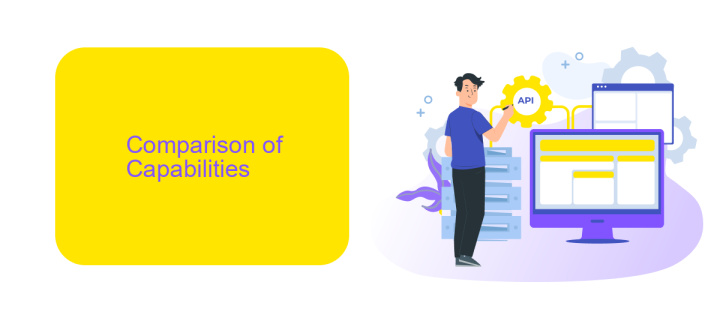UiPath Vs MuleSoft
In the rapidly evolving landscape of enterprise automation, UiPath and MuleSoft have emerged as leading platforms, each offering unique capabilities. UiPath excels in robotic process automation (RPA), streamlining repetitive tasks, while MuleSoft specializes in API-led connectivity, enabling seamless integration across diverse systems. This article delves into a comparative analysis of UiPath and MuleSoft, helping organizations choose the right tool for their automation needs.
Introduction
In today's rapidly evolving digital landscape, businesses are increasingly relying on automation and integration platforms to streamline their operations and enhance productivity. Two popular solutions that have gained significant traction are UiPath and MuleSoft. While both platforms offer robust capabilities, they cater to different needs and use cases, making it crucial for organizations to understand their unique features and benefits.
- UiPath: Specializes in robotic process automation (RPA) to automate repetitive tasks.
- MuleSoft: Focuses on integration and API management to connect disparate systems.
- ApiX-Drive: Facilitates seamless integration between various applications and services without coding.
Choosing the right platform depends on your specific business requirements. UiPath excels in automating routine tasks, reducing human error, and freeing up valuable resources. MuleSoft, on the other hand, is ideal for complex integration scenarios, enabling seamless data flow across multiple systems. Additionally, tools like ApiX-Drive can complement these platforms by providing easy-to-use integration solutions, further enhancing your automation and integration strategies. Understanding these differences will help you make an informed decision that aligns with your organizational goals.
Comparison of Capabilities

UiPath and MuleSoft are powerful tools in the realm of automation and integration, yet they serve different purposes. UiPath excels in robotic process automation (RPA), enabling businesses to automate repetitive tasks with ease. Its user-friendly interface and drag-and-drop functionality make it accessible for users with minimal coding experience. On the other hand, MuleSoft specializes in integration, providing a robust platform for connecting various applications and data sources. Its Anypoint Platform offers comprehensive tools for API management, enabling seamless data flow across systems.
While UiPath focuses on task automation, MuleSoft emphasizes end-to-end integration. However, both can complement each other in a hybrid environment. For instance, using a service like ApiX-Drive can bridge the gap between UiPath's RPA capabilities and MuleSoft's integration strengths. ApiX-Drive facilitates the connection of diverse applications, ensuring data consistency and streamlined workflows. This synergy allows businesses to leverage the strengths of both platforms, achieving higher efficiency and better resource management.
Implementation Considerations

When considering the implementation of either UiPath or MuleSoft, it is essential to evaluate several key factors to ensure a successful deployment. Both platforms offer unique capabilities that cater to different business needs and integration requirements.
- Integration Complexity: Assess the complexity of the systems you need to integrate. MuleSoft is known for its robust API management and integration capabilities, while UiPath excels in automating repetitive tasks.
- Scalability: Determine the scalability requirements of your organization. MuleSoft provides extensive scalability options for large-scale integrations, whereas UiPath is ideal for scaling automation processes across various departments.
- Ease of Use: Consider the ease of use and learning curve for your team. UiPath offers a user-friendly interface with drag-and-drop functionalities, making it accessible for non-technical users. MuleSoft, on the other hand, may require more technical expertise.
- Integration Tools: Evaluate the tools and services available for integration. Services like ApiX-Drive can simplify the integration process by providing pre-built connectors and automation capabilities, enhancing the efficiency of both UiPath and MuleSoft implementations.
Ultimately, the choice between UiPath and MuleSoft depends on your specific business needs, the complexity of integrations, and the technical expertise of your team. By carefully considering these factors, you can ensure a seamless and effective implementation that aligns with your organizational goals.
Advantages and Disadvantages

UiPath and MuleSoft are two powerful tools in the realm of automation and integration. UiPath excels in robotic process automation (RPA) by providing an easy-to-use interface for creating automated workflows. MuleSoft, on the other hand, shines in the integration space, enabling seamless connectivity between various applications and data sources.
One of the main advantages of UiPath is its user-friendly design, which allows non-developers to create complex automation processes with minimal coding. MuleSoft's strength lies in its ability to integrate disparate systems, making data flow smoothly across different platforms.
- UiPath: User-friendly interface, extensive RPA capabilities, strong community support.
- MuleSoft: Robust integration features, supports a wide range of connectors, scalable architecture.
- ApiX-Drive: Simplifies integration setup, user-friendly, cost-effective.
However, both tools have their drawbacks. UiPath can become costly as automation needs scale, and it may require additional resources for complex tasks. MuleSoft, while powerful, can be challenging to learn and implement without proper expertise. Tools like ApiX-Drive can help bridge the gap by offering simpler integration solutions, making it easier for businesses to connect various systems without extensive technical knowledge.
Conclusion
In conclusion, both UiPath and MuleSoft offer robust solutions for different aspects of automation and integration. UiPath excels in robotic process automation (RPA), providing a user-friendly interface and extensive capabilities for automating repetitive tasks. On the other hand, MuleSoft specializes in API management and integration, enabling seamless connectivity across various systems and applications.
When deciding between UiPath and MuleSoft, it is crucial to consider your specific business needs. For organizations focused on automating internal processes, UiPath might be the better choice. However, if your goal is to integrate diverse systems and manage APIs effectively, MuleSoft stands out. Additionally, leveraging services like ApiX-Drive can further enhance your integration efforts, offering a straightforward way to connect and automate workflows between different platforms. Ultimately, the right tool depends on your unique requirements and long-term strategic goals.


FAQ
What are the primary differences between UiPath and MuleSoft?
Which tool is better for automating repetitive tasks in a business process?
Can I use UiPath and MuleSoft together?
What are the deployment options for UiPath and MuleSoft?
Are there services available to help implement and integrate these tools?
Apix-Drive will help optimize business processes, save you from a lot of routine tasks and unnecessary costs for automation, attracting additional specialists. Try setting up a free test connection with ApiX-Drive and see for yourself. Now you have to think about where to invest the freed time and money!

